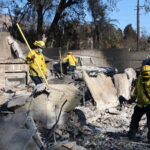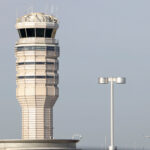Last year’s weather hazards reflected a mostly average season, with the exception of wildfires in California and flooding as a result of Hurricanes Harvey and Irma, according to CoreLogic’s annual Natural Hazard Risk Summary and Analysis released last week.
The annual report reviews hazard activity in the U.S. including events for flooding, earthquake, wildfire, wind, hail, tornado and hurricanes, as well as several international events including Hurricane Maria in Puerto Rico, a Magnitude 7.1 earthquake in Mexico and Cyclone Debbie in Australia. Highlights from the analysis include:
Flood
Flooding from Hurricanes Harvey and Irma resulted in an estimated $69 billion to $105 billion in residential and commercial damage. Flood damage in Texas from Hurricane Harvey is estimated at $40 billion to $59 billion, of which $25 billion to $37 billion is residential damage and $15 billion to $22 billion is commercial damage Approximately 75 percent of the flood damage to residential properties from Hurricane Harvey was uninsured.
Flood damage in Florida, Alabama, Georgia, North Carolina and South Carolina from Hurricane Irma is estimated at $29 billion to $46 billion, of which $25 billion to $38 billion is residential damage and $4 billion to $8 billion is commercial damage.
Approximately 80 percent of the flood damage to residential properties from Hurricane Irma was uninsured.
California and the Midwest also experienced significant rainfall that resulted in flooding. According to the National Centers for Environmental Information (NCEI), total property loss from the California winter floods is estimated at $1.5 billion and total property loss from the Midwest (between Oklahoma and Ohio) April/May flooding is estimated at $1.7 billion.
Atlantic Hurricanes
Hurricane activity in the Atlantic was higher than average in 2017 with 17 named storms, 10 hurricanes and six major hurricanes, which are identified as Category 3 or greater.
Hurricane Harvey, a Category 4 storm that made landfall in Texas, caused an estimated $1 billion to $2 billion in insured wind and storm surge loss to both residential and commercial properties, and Hurricane Irma, a Category 4 storm that made landfall in South Florida, caused an estimated $14 billion to $19 billion in insured wind and storm surge loss to both residential and commercial properties.
Wind
Due in large part to the strong winds brought by Hurricanes Harvey and Irma, the land area impacted by severe winds (>80 mph) in 2017 was more than four times greater than in 2016. Port Aransas, Texas recorded the highest wind speed of the year at 131 mph during Hurricane Harvey Western Nebraska recorded the strongest wind gust associated with severe thunderstorms of the year at 115 mph on June 26
At 37 percent, more than one-third of the continental U.S. experienced wind events of 60 mph or higher in 2017.
Wildfire
The total number of acres burned (9,791,062, acres) in 2017 is the third highest in U.S. history, preceded by 2015 (10,125,149 acres) and 2006 (9,873,745 acres).
The 10 most destructive wildfires in 2017, in terms of structures destroyed, were in California and include:
- The Tubbs Fire in northern California which burned 36,807 acres and 5,643 structures. Until the Tubbs Fire, the two worst wildfires in California history – Tunnel in 1991 and Cedar in 2003 – destroyed 5,720 structures combined.
- The Nuns Fire in northern California which burned 54,382 acres and 1,355 structures.
- The Thomas Fire in southern California which burned 281,893 acres and 1,063 structures.
- The Atlas Fire in northern California which burned 51,624 acres and 781 structures.
- The Redwood Valley Fire in southern California which burned 36,523 acres and 544 structures.
- The Cascade Fire in northern California which burned 9,989 acres and 398 structures.
- The Lilac Fire in southern California which burned 4,100 acres and 157 structures.
- The Detwiler Fire in Mariposa County, California which burned 81,826 acres and 131 structures.
- The Creek Fire in southern California which burned 15,619 acres and 123 structures.
- The Helena Fire in Trinity County, California which burned 21,846 acres and 123 structures.
Earthquake
As of December 1, there were 818 identified earthquakes of Magnitude 3.0 or greater across the country. In 2016, approximately 60 percent of the total number of earthquakes occurred in Oklahoma compared with only 28 percent in 2017
The most notable earthquake events in 2017 include:
- A Magnitude 5.8 earthquake near Lincoln, Montana on July 6
- A Magnitude 5.3 earthquake near Soda Springs, Idaho on September 2
- A Magnitude 4.1 earthquake in Delaware on November 30
Hail
Hail activity for 2017 was near average with 168,905 square miles, or 5.5 percent, of the continental U.S. impacted by severe hail, defined as 1″ or greater.
Denver, Colorado experienced the worst of this natural hazard with estimated losses of $1.4 billion from approximately 150,000 auto insurance claims and approximately 50,000 homeowner insurance claims.
Tornadoes
The number of tornadoes in 2017 was above average with 1,522 recorded tornadoes, making it the third most active year since 2005.
With 81 confirmed tornadoes between Mississippi and Georgia, the month of January experienced the most tornado activity in 2017.
Source: CoreLogic
Was this article valuable?
Here are more articles you may enjoy.

 Teen’s Suicide Turns Mother Against Google, AI Chatbot Startup
Teen’s Suicide Turns Mother Against Google, AI Chatbot Startup  California Man Wins $50M in Lawsuit Over Burns From Starbucks Tea
California Man Wins $50M in Lawsuit Over Burns From Starbucks Tea  New Fire Maps Put Nearly 4M Californians in Hazardous Zones
New Fire Maps Put Nearly 4M Californians in Hazardous Zones  FAA Must Do Better After Midair Collision, Acting Chief Says
FAA Must Do Better After Midair Collision, Acting Chief Says 